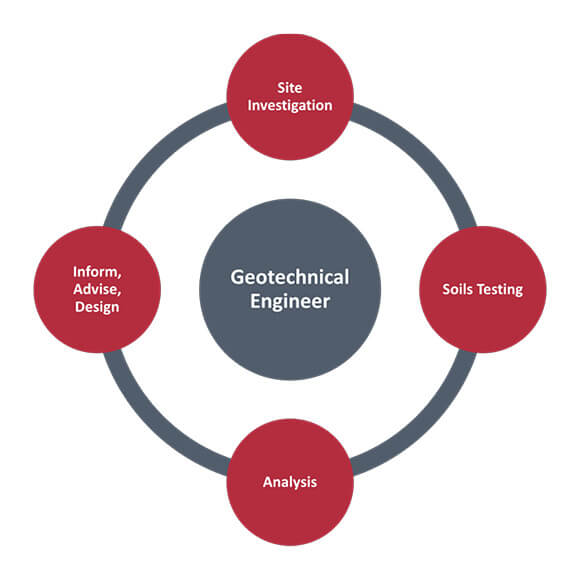3 Simple Techniques For Geotheta
3 Simple Techniques For Geotheta
Blog Article
The Ultimate Guide To Geotheta
Table of ContentsGetting My Geotheta To WorkGeotheta - The FactsThe Single Strategy To Use For GeothetaWhat Does Geotheta Mean?Little Known Questions About Geotheta.

They conduct site examinations, collect samples, execute laboratory tests, and examine information to evaluate the viability of the ground for building and construction projects - Geotechnical Engineers. Based upon their searchings for, geotechnical designers provide suggestions for structure layout, incline security, retaining structures, and mitigation of geotechnical risks. They work together with various other specialists, such as engineers, structural designers, and building teams, to make sure that geotechnical considerations are incorporated into the overall task layout and execution
By assessing the behavior and residential properties of dirt and rock, they can recognize possible geotechnical dangers such as landslides, soil negotiation, or slope instability. Their know-how assists stop failures or mishaps that might threaten lives and residential property. Right here are some in-depth tasks and obligations of a geotechnical engineer: Site Examination: Geotechnical designers conduct website investigations to gather data on subsurface problems.
They interpret the information to recognize the homes and habits of the dirt and rock, including their toughness, leaks in the structure, compaction characteristics, and groundwater conditions. Geotechnical Evaluation and Layout: Geotechnical designers analyze the data collected during site examinations to evaluate the stability and suitability of the site for construction projects. They perform geotechnical calculations and modeling to assess elements such as bearing capacity, negotiation, incline stability, lateral planet stress, and groundwater circulation.
The Main Principles Of Geotheta
Foundation Layout: Geotechnical engineers play an important role in designing structures that can safely sustain the designated framework. They evaluate the dirt conditions and tons requirements to figure out the suitable foundation kind, such as superficial foundations (e.g., grounds), deep foundations (e.g (https://experiment.com/users/geotheta)., piles), or specialized techniques like soil improvement. They consider factors such as negotiation restrictions, bearing capacity, and soil-structure communication to establish ideal foundation layouts
They assess building and construction plans, monitor website tasks, and carry out area examinations to validate that the style suggestions are followed. If unforeseen geotechnical concerns occur, they evaluate the circumstance and give recommendations for removal or changes to the layout. Danger Assessment and Reduction: Geotechnical engineers analyze geotechnical threats and dangers associated with the task website, such as landslides, liquefaction, or soil disintegration.

Cooperation and Interaction: Geotechnical engineers function carefully with various other experts included in a task, such as architects, architectural engineers, and construction groups. Effective interaction and partnership are vital to integrate geotechnical factors to consider into the total job design and building procedure. Geotechnical engineers provide technological know-how, answer questions, and guarantee that geotechnical needs are satisfied.
Top Guidelines Of Geotheta
Here are some sorts of geotechnical designers: Structure Engineer: Foundation designers concentrate on designing and examining structures for structures. They evaluate the dirt problems, lots requirements, and site attributes to determine the most suitable foundation kind and layout, such as superficial structures, deep structures, or specialized strategies like heap structures.
They evaluate the factors influencing incline security, such as dirt residential or commercial properties, groundwater conditions, and slope geometry, and establish methods to protect against incline failings and minimize threats. Quake Designer: Quake designers concentrate on examining and making frameworks to withstand seismic pressures. They analyze the seismic risk of a website, evaluate soil liquefaction possibility, and create seismic style standards to make certain the security and resilience of frameworks throughout quakes.
They perform field testing, gather examples, and analyze the accumulated information to define the soil residential or commercial properties, geologic developments, and groundwater conditions at a site. Geotechnical Instrumentation Engineer: Geotechnical instrumentation engineers concentrate on monitoring and gauging the habits of soil, rock, and structures. They set up and keep instrumentation systems that check factors such as dirt settlement, groundwater degrees, slope activities, and architectural variations to analyze performance and give very early warnings of potential concerns.
Getting My Geotheta To Work
They carry out examinations such as triaxial tests, debt consolidation examinations, direct shear examinations, and permeability tests to collect data for geotechnical analysis and layout. Geosynthetics Engineer: Geosynthetics engineers concentrate on the design and application of geosynthetic products, such as geotextiles, geogrids, and geomembranes. They make use of these materials to enhance dirt security, reinforce slopes, give drainage services, and control disintegration.
They tend to be investigative individuals, which implies they're intellectual, introspective, and analytical. They are interested, systematic, sensible, logical, and sensible. Some of them are additionally social, suggesting they're kind, charitable, participating, individual, caring, handy, understanding, sensible, and pleasant - Consulting Engineers.
In the workplace setting, geotechnical engineers make use of specialized software tools to perform calculations, produce designs, and analyze information. They prepare records, testimonial job specifications, communicate with customers Get More Information and group participants, and coordinate project activities. The workplace setting offers a helpful setting for research study, analysis, and collaboration with various other experts included in the project.
The Ultimate Guide To Geotheta
They often visit task websites to conduct website investigations, assess geotechnical problems, and gather data for evaluation. These check outs involve traveling to various locations, often in remote or challenging terrains. Geotechnical designers may do soil sampling, conduct examinations, and monitor building tasks to guarantee that the geotechnical facets of the project are being carried out correctly.
Geotechnical designers likewise operate in specialized geotechnical research laboratories. In these facilities, they conduct experiments, execute examinations on soil and rock examples, and assess the engineering residential or commercial properties of the materials. Geotechnical research laboratory engineers work thoroughly in these settings, handling testing devices, running instruments, and taping information. They collaborate with other lab personnel to make certain exact and dependable testing outcomes.
Report this page